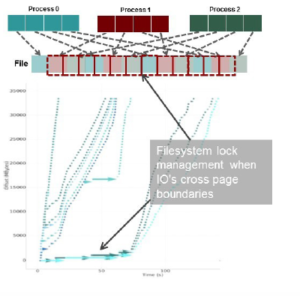Businesses with I/O-intensive computing environments run into new software challenges almost daily – and many of these concerns today revolve around storage as data continues to grow. DDN is working to help solve one of these challenges to avoid storage bottlenecks.

Download the full white paper now.
There is a need for a new approach to fast I/O. There are a variety of factors creating this demand, such as improvement of non-volatile memory device technologies, diverse many-core processor strategies, and more. Flash-based media simply doesn’t have the same characteristics as HDD and requires a different approach.
DDN has launched a new software solution that manages at-scale flash to eliminate file system bottlenecks and voids old rules for application I/O optimization. DDN’s Infinite Memory Engine (IME) is a scale-out, flash-native, software-defined, storage cache.
But the company explained in a recent white paper, “Infinite Memory Engine: A Scale-Out Storage Cache for the Flash Era,” the tool handles I/O “very differently” from conventional file systems.
DDN has launched a new software solution that manages at-scale flash to eliminate file system bottlenecks and voids old rules for application I/O optimization.
“IME delivers new levels of I/O performance independent of total storage capacity,” the white paper states. “This new dimension in system architecture allows system designs with order of magnitude reductions in hardware.”
DDN explained its team had recognized for some time now the “limitations” of file systems in the face of increasing I/O demands. How does the new product differentiate itself? By processing application I/O without the file system, IME works to make app performance more predictable and can speed up I/O-intensive applications.
So, how does it work? The white paper goes into detail regarding software architecture, but ultimately, IME is software with a server and a client component.
“While IME maintains file system semantics and therefore requires no application modifications, it is not a file system but rather an I/O system plus cache,” DDN explains.
[clickToTweet tweet=”IME from DDN offers non-deterministic data placement using a parallel file system for I/O consistency.” quote=”IME from DDN offers non-deterministic data placement using a parallel file system for I/O consistency.”]
IME offers non-deterministic data placement using a parallel file system for I/O consistency.

Parallel file systems can exhibit extremely poor performance for shared file I/O, due to internal lock management as a result of managing files in large lock units. (Photo: DDN)
Further, IME was developed from the ground up for non-volatile memory devices, and also implements some new principles in managing data protection and component failure.
IME software provides a scalable framework in which to implement a scale-out flash I/O system above a parallel file system, and DDN outlines in its recent report a variety of use cases for the software, such as machine learning, large-scale read challenges and more.
For a more in-depth look at the new IME software, download the full white paper, “Infinite Memory Engine: A Scale-Out Storage Cache for the Flash Era,” courtesy of DDN.



